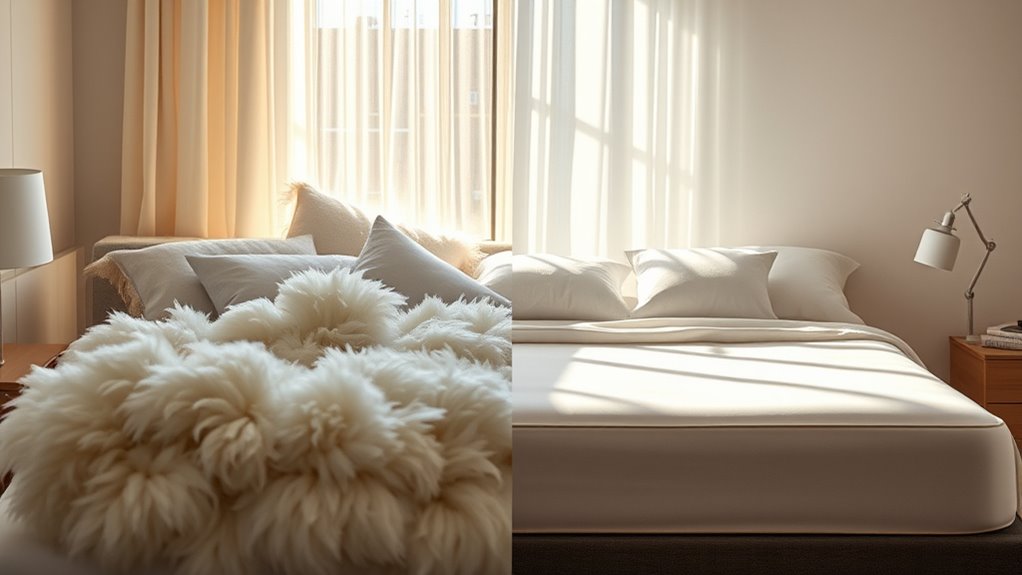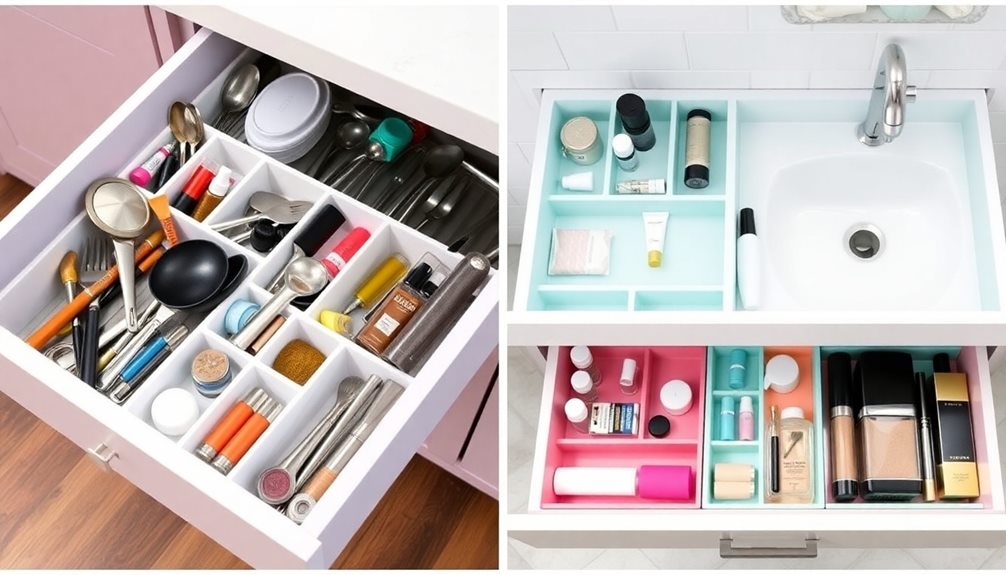When deciding between featherbeds and memory foam toppers, think about your sleep preferences. If you love extreme softness and natural temperature regulation, a featherbed might be right for you. On the other hand, if you need support and pressure relief, especially as a side sleeper, memory foam is ideal. Each option has its own maintenance needs and lifespan. If you want to explore more about which topper fits your lifestyle best, there’s plenty more to contemplate.
Key Takeaways
- Featherbeds offer extreme softness and coziness, ideal for those prioritizing a plush sleeping surface.
- Memory foam provides personalized support and pressure relief, especially beneficial for side sleepers.
- Featherbeds excel in temperature regulation, keeping users comfortable in both winter and summer.
- Memory foam retains body heat, which may cause overheating for some users.
- Consider your budget: featherbeds range from $50 to $200, while memory foam can exceed $300 based on quality.
Understanding Mattress Toppers
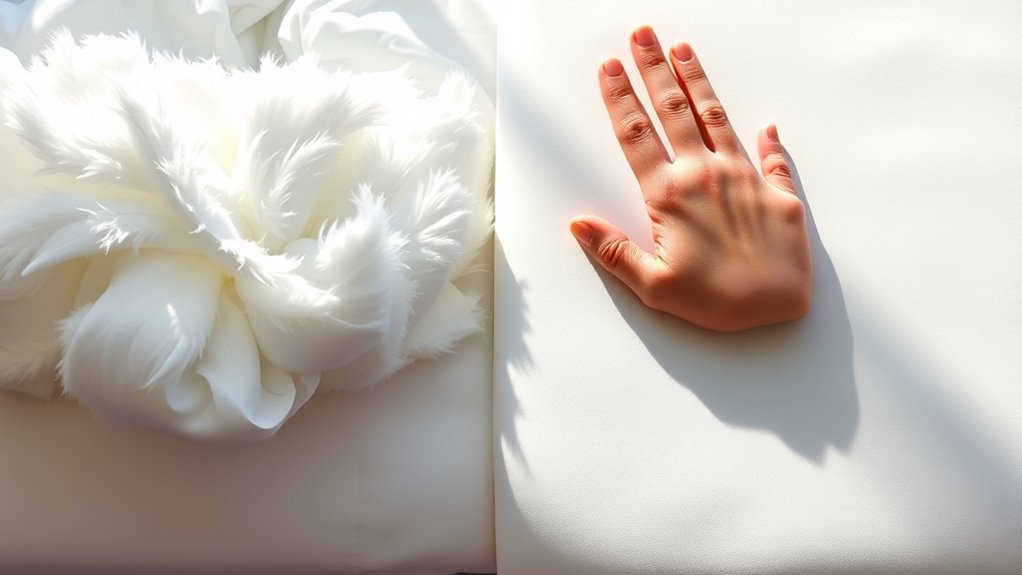
When you’re looking to enhance your sleep experience, understanding mattress toppers is key.
These thick cushioned layers, available in materials like memory foam and feather, greatly improve comfort and support. Ranging in height from 3 to 8 cm, they can easily be secured to your mattress with elastic bands, ensuring stability throughout the night. Regular maintenance is essential for optimal functionality, just as it is for your toilet to ensure effective flushing. Additionally, incorporating essential oils for relaxation into your bedtime routine can further enhance your sleep quality. Proper care of your mattress topper can also enhance its durability and performance, similar to how air purifier maintenance ensures effective air quality. Staying well-hydrated is also crucial for improving sleep quality and overall well-being, as dehydration can lead to fatigue and discomfort.
Memory foam toppers adapt to your body heat and pressure, providing personalized support and effective pressure relief, while feather toppers offer a soft, cozy feel with excellent temperature regulation. Additionally, regular maintenance, such as washing every three months, is essential to keep them hygienic and prolong their lifespan, similar to how glycolic acid aids in exfoliation and promotes scalp health.
Investing in mattress toppers is a cost-effective way to boost your sleep quality and extend the life of your mattress.
Benefits of Featherbeds
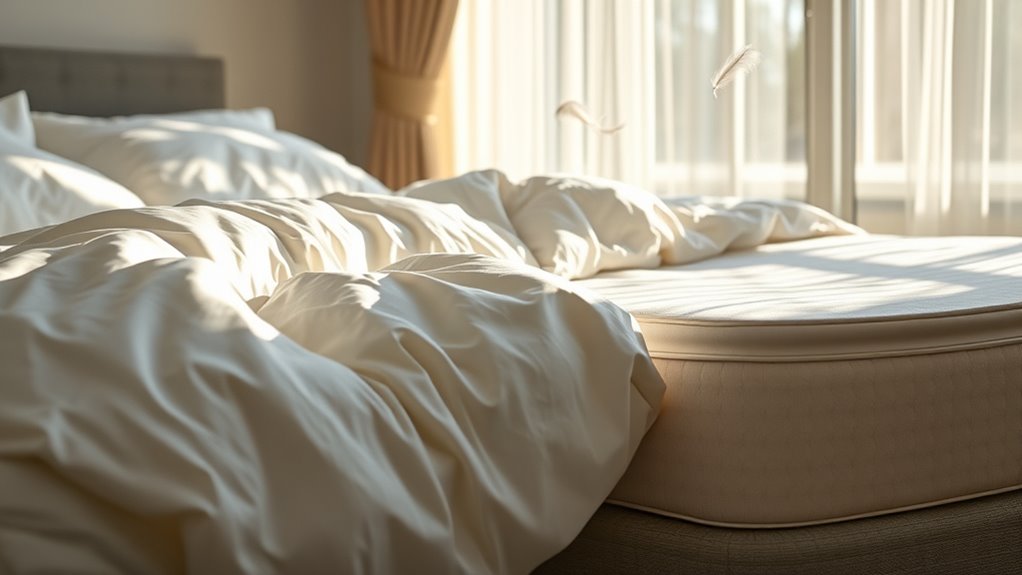
Featherbeds offer a luxurious sleeping experience that can transform your nights into a cozy retreat. Filled with 90% European down and 10% small feathers, these toppers provide exceptional softness, making your bed feel like a cloud. Their natural temperature regulation guarantees you stay warm in winter and cool in summer. Additionally, featherbeds are easy to clean and maintain compared to traditional mattresses, ensuring they remain fresh and comfortable over time. Regular maintenance tips for air purifiers can help enhance their longevity and efficiency. Furthermore, investing in a featherbed can be a part of your overall financial realignment post-separation, helping you create a comfortable living space during a transitional period. Moreover, many people choose to enhance their workspaces with low light office plants to create a calming environment that complements their sleep quality.
| Feature | Description |
|---|---|
| Exceptional Softness | Light and fluffy for ultimate comfort |
| Natural Temperature Regulation | Keeps you cozy year-round |
| Hypoallergenic | Reduces dust mite retention |
Moreover, featherbeds conform to your body, minimizing movement during sleep. They’re durable, lasting for years with proper care, offering a great investment in your sleep quality. With all these benefits, a featherbed might just be your perfect match! Additionally, their natural temperature regulation contributes to a more comfortable sleep environment, similar to the advancements seen in modern bathroom technologies.
Advantages of Memory Foam Toppers
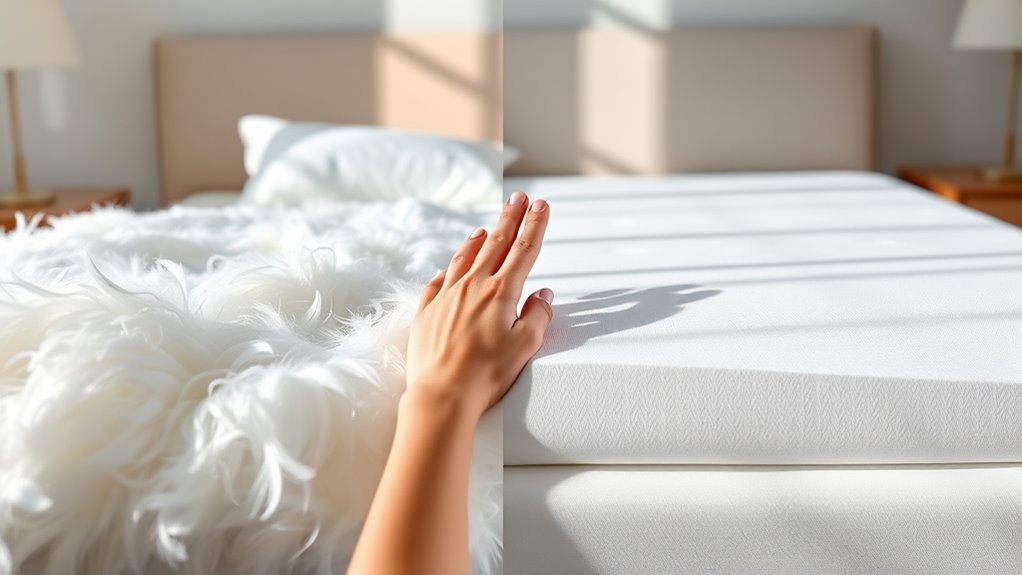
Although you might be accustomed to traditional mattresses, memory foam toppers can revolutionize your sleep experience.
These mattress toppers adapt to your body heat and pressure, providing personalized comfort that minimizes tossing and turning. If you suffer from back pain, thicker memory foam options (4-5 lbs density) can deliver the support you need, especially for side sleepers.
Additionally, memory foam is hypoallergenic, resisting allergens like dust mites, making it a great choice for allergy sufferers.
Memory foam’s hypoallergenic properties resist allergens, making it an excellent choice for those with allergies.
You’ll also appreciate how these toppers extend the lifespan of your existing mattress, reducing wear and tear and saving you money in the long run.
Plus, the absence of springs guarantees a quiet sleeping experience, allowing for undisturbed rest even with partner movements.
Comparing Comfort Levels
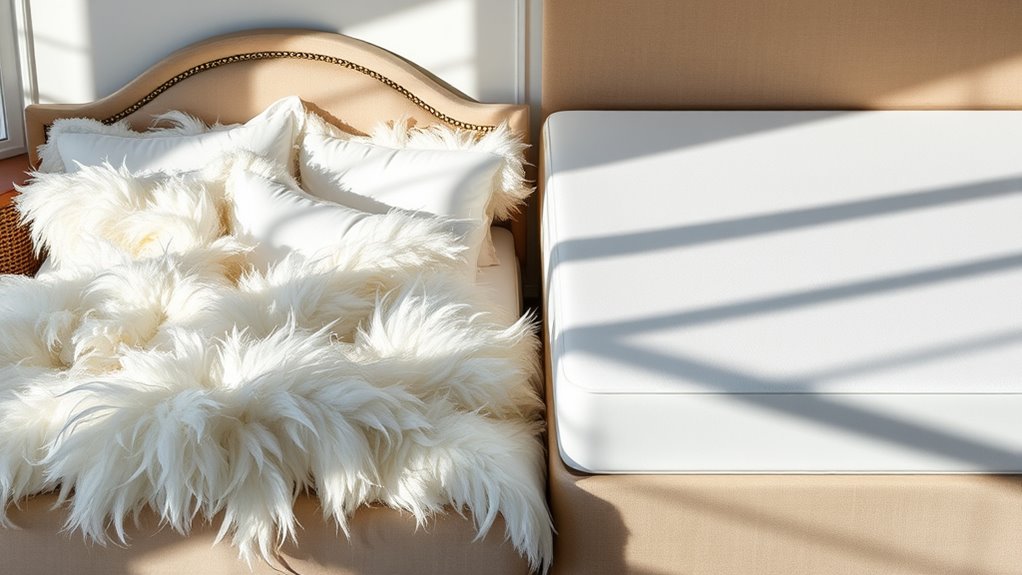
When it comes to comfort, you’ve got two distinct experiences with featherbeds and memory foam.
If you crave softness and a cozy embrace, featherbeds might be your go-to.
On the other hand, if support and pressure relief are what you need for a good night’s sleep, memory foam could be the better choice.
Softness and Coziness
Finding the perfect balance of softness and coziness in your bedding can dramatically enhance your sleep experience.
Featherbeds offer an extreme softness with a light, fluffy feel that wraps around you, creating a luxurious and cozy environment. This plush surface feels gentle against your skin, making it ideal for those who crave comfort.
In contrast, memory foam conforms to your body but tends to be firmer, leading to a sinking sensation that some might find less cozy. Additionally, memory foam is hypoallergenic, making it a better choice for individuals with allergies, while featherbeds can trigger sensitivities due to their natural materials.
Consider your comfort preferences and any allergy concerns when deciding between these two options for a restful night’s sleep.
Support and Pressure Relief
While softness and coziness play a significant role in your sleep comfort, support and pressure relief are equally important for a restful night.
Memory foam excels in providing personalized support by conforming to your body shape, relieving pressure points that can cause neck and back pain. This feature helps minimize tossing and turning, leading to a deeper sleep.
In contrast, featherbeds offer a luxurious feel but may lack the necessary firmness for adequate spinal alignment, potentially leading to discomfort over time. They can compress, losing their loftiness and support.
If you want a good night’s sleep, a memory foam topper on a firm mattress strikes a balance between softness and support, ensuring you enjoy both pressure relief and comfort.
Maintenance and Care
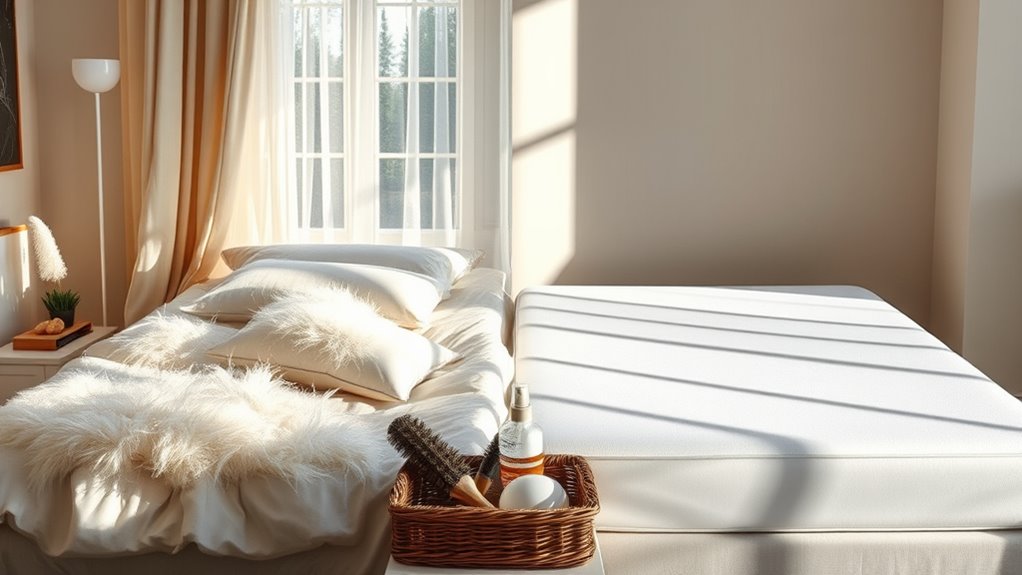
Proper maintenance and care can greatly extend the life of both featherbeds and memory foam toppers. For featherbeds, regularly fluffing and machine-washing at 30° keeps them fresh and in shape. Memory foam requires spot cleaning and airing out for a couple of days before use to eliminate odors.
| Featherbeds | Memory Foam | Maintenance Tips |
|---|---|---|
| Fluff regularly | Spot clean only | Follow manufacturer guidelines |
| Machine-wash at 30° | Air out before use | Regularly clean for hygiene |
| Lasts 3-5 years | Lasts 1-2 years | Prevent clumping of feathers |
Which Material Suits Your Sleeping Style?
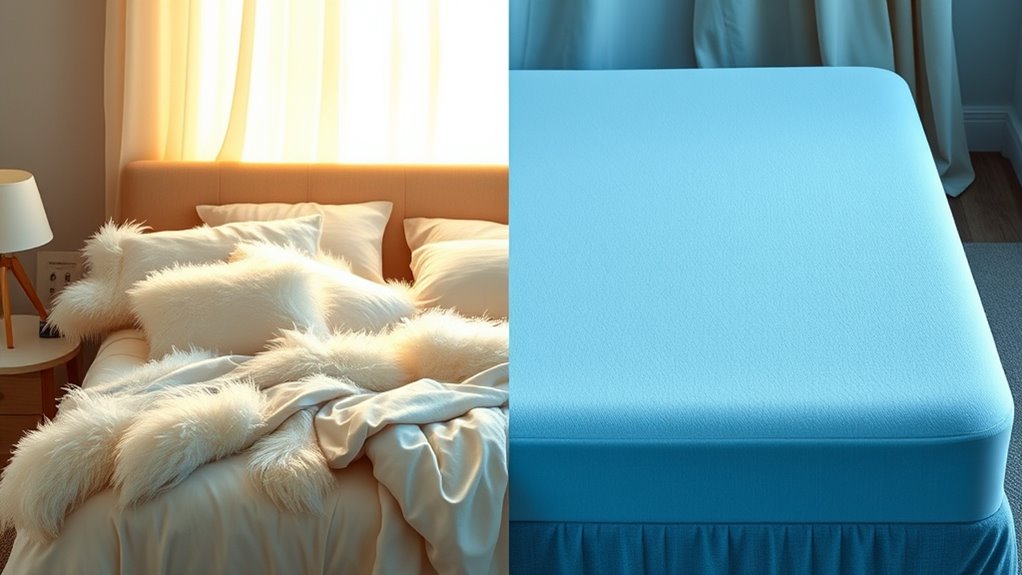
When choosing between featherbeds and memory foam, consider your support needs and temperature preferences.
If you need pressure relief and support, especially as a side sleeper, memory foam is likely your best bet.
On the other hand, if you prefer a soft, cooler surface, a featherbed might be more suitable for your sleeping style.
Support Needs Assessment
How do you know which material best suits your sleeping style? Start with a support needs assessment.
If you often wake up with back or neck pain, memory foam is your best bet. It conforms to your body, alleviating pressure points and providing the extra support you need.
On the other hand, if you prefer a softer, cozier experience and don’t require as much firmness, featherbeds might be more to your liking.
Side sleepers usually benefit from memory foam, while back sleepers may enjoy the plushness of featherbeds.
Don’t forget to take into account allergies; memory foam is hypoallergenic and resists dust mites, while featherbeds mightn’t be suitable for those sensitive to natural materials like feathers.
Choose wisely!
Temperature Regulation Preferences
While you might prioritize comfort and support when choosing a sleep surface, temperature regulation can be just as essential for a restful night.
If you tend to sleep hot or live in warmer climates, memory foam mightn’t be your best friend; it retains body heat and can lead to overheating.
On the other hand, featherbeds excel in temperature regulation, keeping you cozy in winter and cool in summer. Their natural materials promote better air circulation, preventing heat and moisture buildup during sleep.
If you appreciate a plush, cozy feel, a featherbed may offer superior comfort while maintaining a comfortable sleeping temperature.
Ultimately, your sleeping style and temperature preferences should guide your choice between these two options.
Cost Considerations
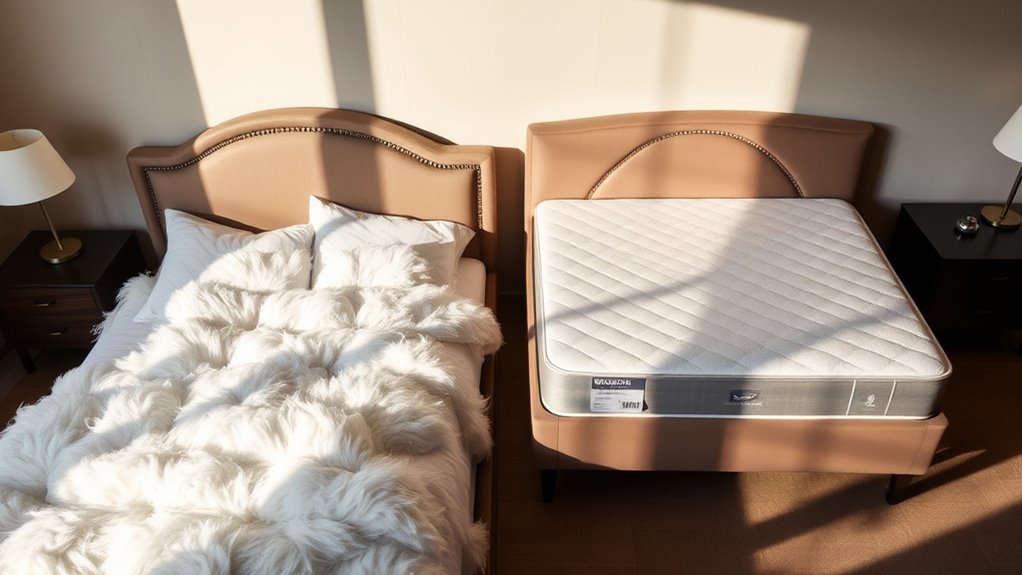
Cost considerations play an essential role in choosing between featherbeds and memory foam toppers.
If you’re looking for an affordable option, mattress pads typically range from $30 to $40, providing basic protection without extra comfort.
Featherbeds are usually priced between $50 and $200, depending on quality and fill material, making them a budget-friendly choice compared to memory foam toppers.
These toppers usually cost between $100 and over $300, reflecting their higher manufacturing costs and material benefits.
Keep in mind that prices can vary considerably based on size, brand, and quality.
Investing in a higher-quality featherbed or memory foam topper can enhance your sleep experience while extending your mattress’s life, ultimately leading to long-term savings.
Final Thoughts on Choosing the Right Topper
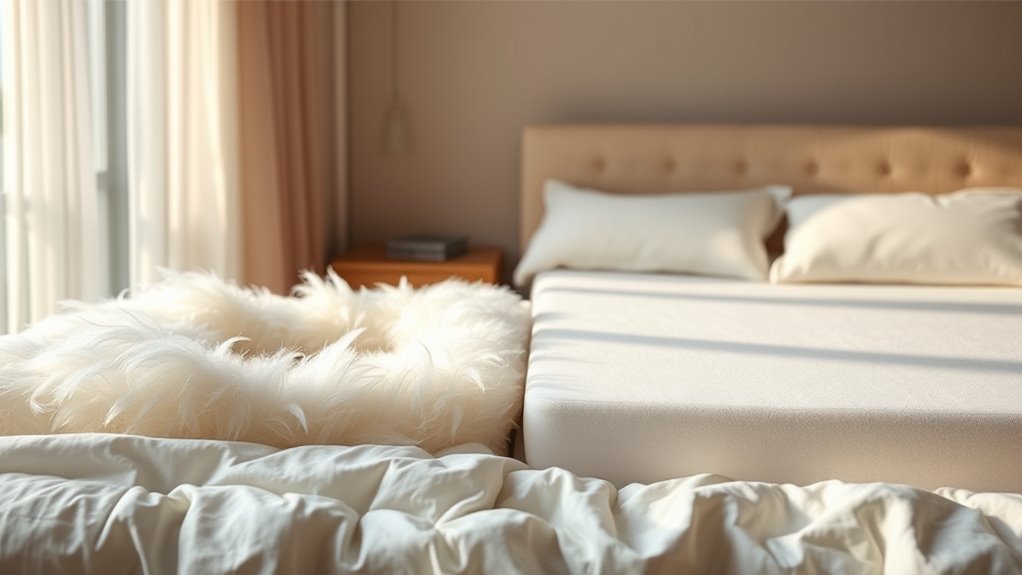
When deciding between a featherbed and a memory foam topper, it is crucial to reflect on your personal sleep preferences and needs. Memory foam offers excellent pressure relief, great for those with neck or back pain, while goose feather provides a soft, plush feel for a cozy sleep experience.
Consider the climate, as memory foam can retain heat, while featherbeds help regulate temperature. Regular maintenance also plays a role; memory foam needs airing out, while featherbeds require fluffing and washing.
Here’s a quick comparison to help you choose:
| Feature | Memory Foam | Goose Feather |
|---|---|---|
| Support | High | Moderate |
| Softness | Firm | Plush |
| Heat Retention | High | Low |
| Maintenance | Moderate | High |
Frequently Asked Questions
Is Feather or Memory Foam Better?
When deciding whether feather or memory foam’s better, it really depends on your needs.
If you want softness and a luxurious feel, you might lean towards featherbeds.
However, if you need support for neck or back pain, memory foam’s conforming properties could be ideal for you.
Consider your allergies too; memory foam’s hypoallergenic nature makes it a safe choice.
Ultimately, think about comfort, support, and maintenance before making your decision.
Why Are People No Longer Buying Memory Foam?
You might notice that people are stepping away from memory foam for several reasons.
Many find it retains heat, making sleep uncomfortable, especially in warmer climates. The initial chemical smell can be off-putting, requiring days to air out.
Others prefer the natural feel of alternatives, valuing breathability and softness.
Additionally, concerns about synthetic materials and the cumbersome weight of memory foam toppers lead some to seek lighter, more sustainable options.
What Mattress Topper Do Chiropractors Recommend?
If you’re looking for a mattress topper, chiropractors often recommend memory foam.
Its ability to conform to your body shape helps maintain proper spinal alignment and alleviates pressure points, which is essential for a good night’s sleep.
A medium-firm memory foam topper is usually suggested as it provides the right balance of support and comfort for various sleeping positions, especially if you’ve got chronic back or neck pain.
You’ll likely find it enhances your overall sleep quality.
What Are the Negatives of Memory Foam Pillows?
Memory foam pillows come with several downsides. They can trap heat, making you feel uncomfortably warm during the night.
You might also notice an unpleasant chemical smell when you first unpack them. If you prefer lighter options, their weight could be cumbersome.
The sinking effect might restrict your movement, making it tough to change positions. Ultimately, if the firmness doesn’t match your needs, you could wake up with neck or back pain.
Conclusion
So, after weighing the pros and cons, you’re still unsure which topper to choose? Isn’t it ironic that the quest for ultimate comfort can lead to such confusion? Whether you sink into the plush embrace of a featherbed or the supportive hug of memory foam, just remember: both options promise sweet dreams. Who knew picking a mattress topper could feel like choosing between a cloud and a marshmallow? Just go with what feels right, and happy sleeping!
